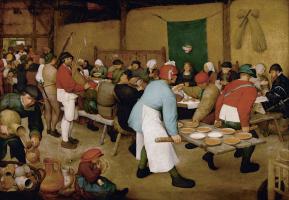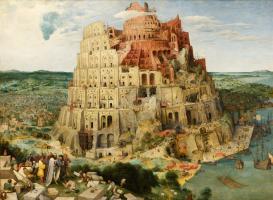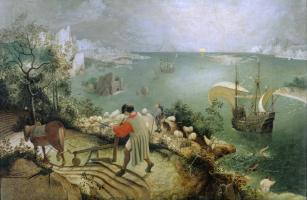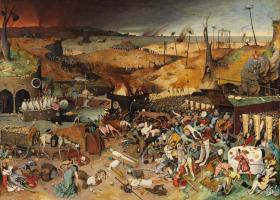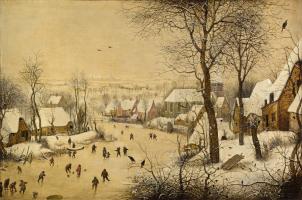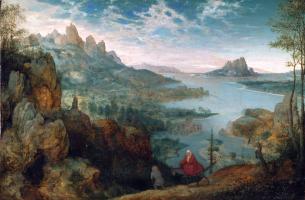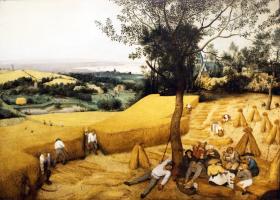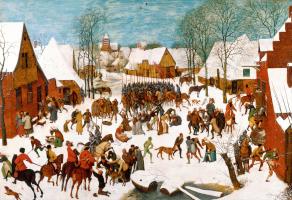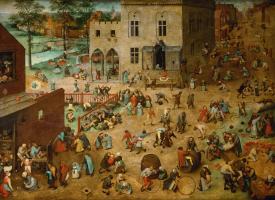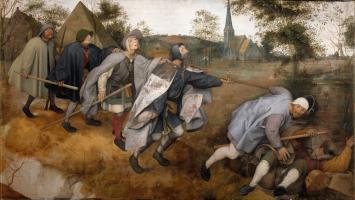Pieter Bruegel, the Elder
Pieter Bruegel was born in Antwerp and spent most of his life there, with a two-year trip to Europe from 1552-4. He went over the Alps to Italy, travelling as far south as Sicily, and the scenery of the Alps had a marked effect on his landscapes.
He depicted man in natural surroundings, leading a simple life, and dependent on the earth and the seasons for survival. He earned the nickname ‘Peasant Bruegel’, not because he was uncultivated which was far from being the case, but because the lives of the Flemish peasants formed such a large part of his subject matter. He showed them working, feasting and celebrating, and exposed their drunkenness, lechery and greed with a gently sarcastic wit. But a religious sincerity and understanding of happiness and suffering were as evident in his pictures as his eye for human weakness. He was interested in the peasants’ customs and in every aspect of their daily lives, and his paintings tell us a great deal about them.
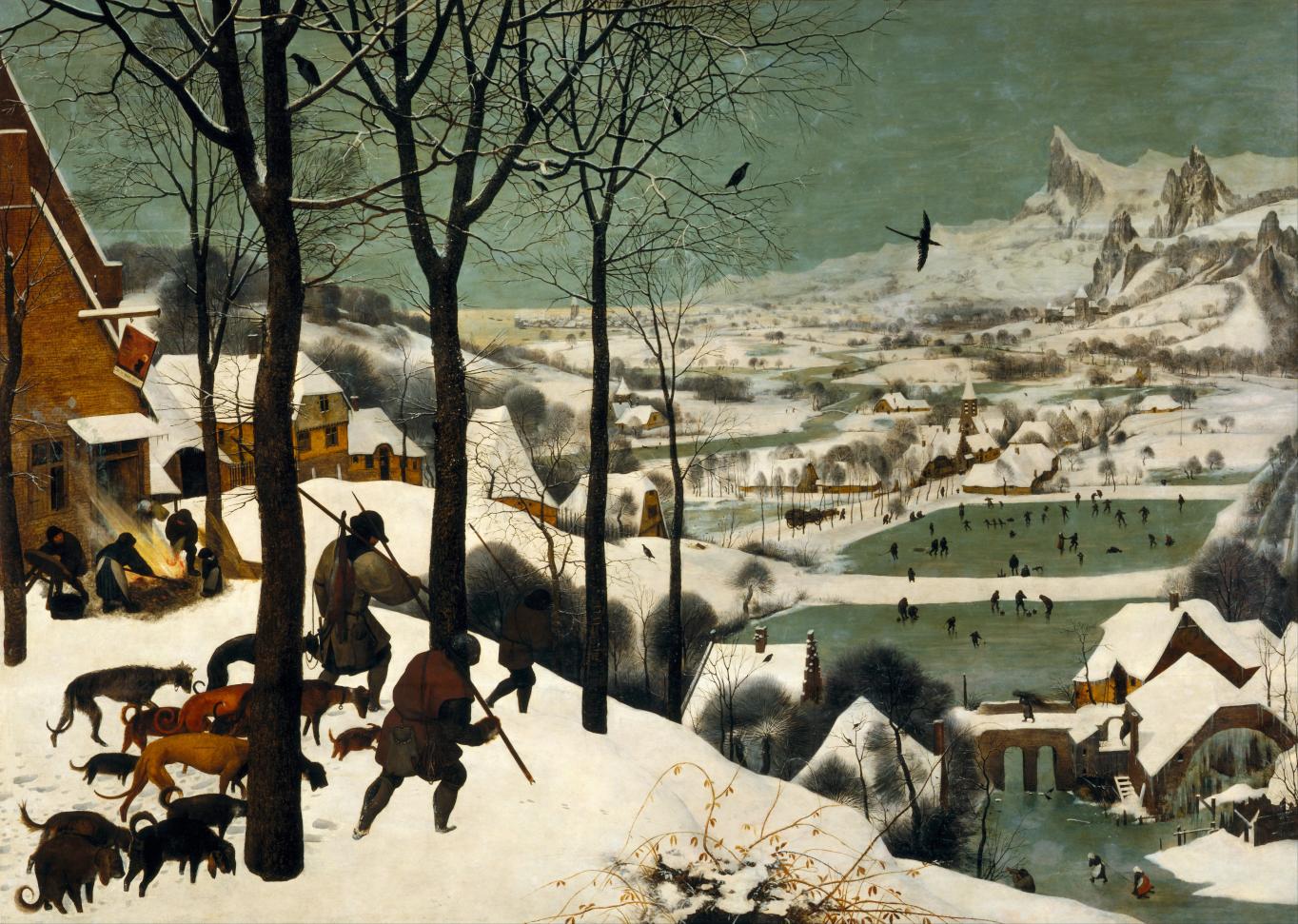 The Return of the Hunters, also known as Winter, is one of a series of
landscapes representing the seasons of the year. Like the others in the cycle,
it has a high vantage point in the foreground and a long vista receding into
the distance. It combines elements of the alpine scenery that Bruegel saw on
his travels with the countryside, houses and people of the Low Countries where
he lived.
The Return of the Hunters, also known as Winter, is one of a series of
landscapes representing the seasons of the year. Like the others in the cycle,
it has a high vantage point in the foreground and a long vista receding into
the distance. It combines elements of the alpine scenery that Bruegel saw on
his travels with the countryside, houses and people of the Low Countries where
he lived.
It is a snow scene, but the signs of companionship and domestic comfort give it a feeling of warmth. Three men are plodding back wearily through the snow, their shoulders bent and their legs heavy, after a hard day’s hunting with their hounds. The line of trees down the hillside emphasizes the steady tramp of their footsteps descending to the village. They pass an inn on the ridge where a group of people are roasting a pig over a blazing fire; and beyond it the roofs of houses follow the line of the ridge down to the valley.
A horse-drawn wagon trundles along a road bordered by feathery trees ; and fields, copses and four churches are scattered over the flat landscape as far as the eye can see, with mountains like alpine crags towering over them.
A river winds its way through the valley, with a bridge crossing it in the middle distance. It has flooded several of the surrounding fields, and the water has frozen into hard green ice. The villagers are taking advantage of it, skating or playing games on the newly-formed frozen lakes. Just below the foreground ridge an old woman trudges across a bridge with a load of twigs on her back for a fire, and a woman in a red skirt is pulled over the ice on a sledge.
The roofs of the houses are long and steep to shed the heavy snow, and icicles hang from the eaves. The bare branches of the trees are like the delicate bones of a skeleton, and the snow on them reflects the icy eerie light.
There is so much detail in the picture that one could look into it for hours in fascination, and its minute observations reveal Bruegel’s familiarity with the countryside and the lives of the people.
 Bruegel’s skill with genre scenes such as this one, depicting hundreds of
little people acting out a catalogue of pastimes, was honed when he was an
engraver with the Antwerp publisher, Hieronymous Cock. His figures are solid
with little modelling but they are wonderfully lively; and beyond the
fascination of identifying all the games and activities, the viewer is treated
to a convincing street perspective on the right, and a delightful glimpse of
typical Flemish landscape on the left.
Bruegel’s skill with genre scenes such as this one, depicting hundreds of
little people acting out a catalogue of pastimes, was honed when he was an
engraver with the Antwerp publisher, Hieronymous Cock. His figures are solid
with little modelling but they are wonderfully lively; and beyond the
fascination of identifying all the games and activities, the viewer is treated
to a convincing street perspective on the right, and a delightful glimpse of
typical Flemish landscape on the left.
 Bruegel’s last major work refers to a quotation from Matthew’s gospel: ‘If the
blind lead the blind, both shall fall into the ditch’. In this solemn allegory
for the human situation, the string of unfortunate people, each clinging
blindly to the next, are jeopardizing their own salvation instead of working
it out for themselves.
Bruegel’s last major work refers to a quotation from Matthew’s gospel: ‘If the
blind lead the blind, both shall fall into the ditch’. In this solemn allegory
for the human situation, the string of unfortunate people, each clinging
blindly to the next, are jeopardizing their own salvation instead of working
it out for themselves.


